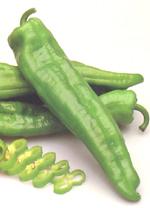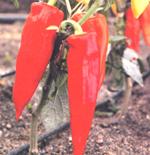| Fruits |
Vegetables
|
Pepper, Capsicum annuum / Solanaceae
|
Note: Composition for 100 g. of fresh product Values in ( min. - max. ) format. | |
| Energy: 32.00-32.00 kcal Fats: 0.40-0.40 g Fibres: 1.60-1.60 g Fat Acids Saturated: 0.10-0.10 gPolyunsat.: 0.20-0.20 g Minerals Calcium: 8.00-8.00 mgZinc: 0.10-0.10 mg Chlorine: 24.00-24.00 mg Phosporus: 22.00-22.00 mg Iron: 0.30-0.30 mg Magnesium: 14.00-14.00 mg Manganese: 0.10-0.10 mg Potasium: 160.00-160.00 mg Sodium: 4.00-4.00 mg Iodine: 1.00-1.00 µg | Proteins: 1.00-1.00 kcal Carbohidrates: 6.40-6.40 g Liposoluble Vitamins A Retinol: 0.00-0.00 µgA Carotenoids: 3840.00-3840.00 µg E or Tocoferol: 0.80-0.80 mg Liposoluble Vitamins B1 or Thiamine: 0.010-0.010 mgB2 or Riboflavine: 0.030-0.030 mg B3 or Niacine: 1.30-1.30 mg B5 or Pantothenic Acid: 0.080-0.080 mg B6 or Piridoxine: 0.36-0.36 mg B9 or Folic Acid: 140.00-140.00 mg C or Ascorbic Acid: 140.00-140.00 mg |

The pepper is a vegetable with variable shape, size and colour. It can be green, red, yellow, orange and even black!. Its taste can be sweet or spicy and it is consumed fresh, preserve, etc.
The pepper is consumed raw, stewed and roasted or as garnish in a great variety of dishes.
The pepper is consumed raw, stewed and roasted or as garnish in a great variety of dishes.
Nutrition and eating
The main vitamin supply in peppers is vitamin C, that protects against cancer. It is also a good source of vitamin A, so it is good for sight.
The fruit
 The pepper is a vegetable with variable shape, size and colour. It can be green, red, yellow, orange and even black!. Its taste can be sweet or hot and it is consumed fresh, as preserve, etc.
The pepper is a vegetable with variable shape, size and colour. It can be green, red, yellow, orange and even black!. Its taste can be sweet or hot and it is consumed fresh, as preserve, etc. The pepper is consumed raw, stewed and roasted or as garnish in a great variety of dishes. They can be sweet or spicy peppers, as the cultivar Tabasco. Moreover, they can be intended for preserve or the manufacture of paprika and as colouring matter.
This fruit or vegetable is an excellent source of vitamin C, 100g represents almost 100% of the recommended consumption, 60 mg/day, and its energetic value is 32kcal. In some cultivars, the content of an alkaloid called capsaicin is responsible spicy or bitter flavour.
The fruits are hollow and voluminous berries, with different size and shape according to the variety. They are formed by two or three carpels, separated by a kind of uncompleted partitions along the fruit wall. They do not reach the centre, so the fruit has only a single cavity in which multiple round and flat seeds grow.
According to the variety or type of pepper, the fruit can be red, green, yellow and even other new colours that are brought in the market, like orange and black.
The prices and the demand on the one hand and the temperatures on the other are the agents that will determine the moment and regularity of the harvesting. In some cases, this will take place before the physiological maturity, whether they are green, red or yellow, depending on the requirements.
If the pepper fruit is put at 0ºC and 87-90% of relative humidity, it may last 4 or 5 weeks; such conditions may vary depending on the period of time between harvesting, handling, transport and marketing.
The plant

This plant, from the species Capsicum annuum, may reach up to 2m in greenhouses. It bears single, whitish flowers.
The pepper belongs to the family of the Solanaceae and most of the varieties cultivated in Europe belong to Capsicum annuum L., although in other places there are cultivated at least four more species: Capsicum fructescens , C. Pubescens, C. Pendulum and C. sirvensis.
The plant is herbaceous perennial with an annual culture cycle, variable habit from 0,5m high (some types cultivated outdoors) to more than 2m (many hybrids under greenhouse).
The root system is pivotal and deep measuring up to 70-120cm, supplied and reinforced with multiple adventitious roots.
The stem is of limited growth and erect, with a habit varying from 0.5 to 1,5cm. At a certain height or crotch it bears 2 or 3 branchings; this dichotomic branching continues until the end of its cycle.
The leaves are hairless, whole, oval or lanceolate, with a very pronounced apex (acuminate) and a long or small petiole. The upperside is glabrous of a more or less intense and bright green colour. The insertion of the leaves in the stem is alternate and its size is variable, the size of the adult leaf bearing some relation with the average weight of the fruit.
The flowers have a white corolla; every stem node has small, single flower. The pollination is autogamous, although it can show a percentage of allogamy inferior to 10%.
The fruit is a semicartilaginous and depressed berry of variable colour (green, red, yellow, orange, violet, white...); some varieties change from green to orange and red during maturation. The shape and size vary; there are varieties that bear fruits of 1 or 2g, althoguh at the same time some berries may weigh more than 500g. The seeds are pale yellow, round, slightly reniform, 3-5mm long, inserted inside a conical placenta in central disposition. One gram of seeds contains around 150 and 200 seeds; their germination power is for 3-4 years.
The pepper belongs to the family of the Solanaceae and most of the varieties cultivated in Europe belong to Capsicum annuum L., although in other places there are cultivated at least four more species: Capsicum fructescens , C. Pubescens, C. Pendulum and C. sirvensis.
The plant is herbaceous perennial with an annual culture cycle, variable habit from 0,5m high (some types cultivated outdoors) to more than 2m (many hybrids under greenhouse).
The root system is pivotal and deep measuring up to 70-120cm, supplied and reinforced with multiple adventitious roots.
The stem is of limited growth and erect, with a habit varying from 0.5 to 1,5cm. At a certain height or crotch it bears 2 or 3 branchings; this dichotomic branching continues until the end of its cycle.
The leaves are hairless, whole, oval or lanceolate, with a very pronounced apex (acuminate) and a long or small petiole. The upperside is glabrous of a more or less intense and bright green colour. The insertion of the leaves in the stem is alternate and its size is variable, the size of the adult leaf bearing some relation with the average weight of the fruit.
The flowers have a white corolla; every stem node has small, single flower. The pollination is autogamous, although it can show a percentage of allogamy inferior to 10%.
The fruit is a semicartilaginous and depressed berry of variable colour (green, red, yellow, orange, violet, white...); some varieties change from green to orange and red during maturation. The shape and size vary; there are varieties that bear fruits of 1 or 2g, althoguh at the same time some berries may weigh more than 500g. The seeds are pale yellow, round, slightly reniform, 3-5mm long, inserted inside a conical placenta in central disposition. One gram of seeds contains around 150 and 200 seeds; their germination power is for 3-4 years.
| Interempresas Media, S.L. / 2025 | [ Legal notice | Política de Protección de Datos | Política de cookies | Publicidad] |
